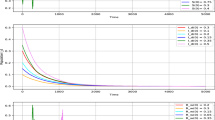Abstract
The SIR epidemic model for disease dynamics considers recovered individuals to be permanently immune, while the SIS epidemic model considers recovered individuals to be immediately resusceptible. We study the case of temporary immunity in an SIR-based model with delayed coupling between the susceptible and removed classes, which results in a coupled set of delay differential equations. We find conditions for which the endemic steady state becomes unstable to periodic outbreaks. We then use analytical and numerical bifurcation analysis to describe how the severity and period of the outbreaks depend on the model parameters.
Similar content being viewed by others
References
Anderson RM, May RM (1991) (eds)Infectious diseases of humans: dynamics and control. Oxford University Press, Oxford, UK
Brauer F, Castillo-Chavez C (2001) Mathematical models in population biology and epidemiology. Springer, New York
Bestehorn M, Grigorieva EV, Haken H, Kaschenko SA (2000) Order parameters for class-B lasers with a long time delayed feedback. Phys D 145: 110–129
Carr TW (2003) Period locking due to delayed feedback in a laser with saturable absorber. Phys Rev E 68: 026212
Carr TW, Billings L, Schwartz IB, Triandaf I (2000) Bi-instability and the global role of unstable resonant orbits in a driven laser. Phys D 247: 59–82
Carr TW, Schwartz IB, Kim M-Y, Roy R (2006) Delayed-mutual coupling dynamics of lasers: scaling laws and resonances. SIAM J Appl Dyn Syst 5: 699–725
Chow S-N, Diekmann O, Mallet-Paret J (1985) Stability, multiplicity and global continuation of symmetric periodic solutions of a nonlinear Volterra integral equation. Jpn J Appl Math 2: 433–469
Cooke K, Van Den Driessche P (1996) Analysis of an SEIRS epidemic model with two delays. J Math Biol 35: 240–260
Cooke K, Van Den Driessche P, Zou X (1999) Interaction of maturation delay and nonlinear birth in population and epidemic models. J Math Biol 39: 332–352
Diekmann O, Montijn R (1982) Prelude to Hopf in an epidemic model: analysis of a characteristic equation associated with a nonlinear volterra integral equation. J Math Biol 14: 117–127
Doedel EJ, Oldeman BE (2007) AUTO-07P: Continuation and bifurcation software for ordinary differential equations. California Institute of Technology and Concordia University
Driver RD (1977) Ordinary and delay differential equations. Springer, New York
Driver RD, Sasser DW, Slater ML (1973) The equation x′(t) = ax(t) + b(t − τ) with ‘small’ delay. Am Math Mon 80: 990–995
Dykman MI, Schwartz IB, Landsman AS (2008) Disease extinction in the presence of random vaccination. Phys Rev Lett 101: 078101
El’sgol’ts LE, Norkin SB (1973) Introduction to the theory and application of differential equations with deviating arguments (translated by J.L.Casti). Academic Press, New York
Engelborghs K, Luzyanina T, Samaey G (2001) DDE-BIFTOOL v. 2.00 user manual: a Matlab package for bifurcation analysis of delay differential equations, Technical Report TW-330, Department of Computer Science, K.E.Leuven, Leuven, Belgium
Grigorieva EV, Kahchenko SA, Loika NA, Samson AM (1992) Nonlinear dynamics in a laser with a negative delayed feedback. Phys D 59: 297
Hethcote HW (2000) The mathematics of infectious diseases. SIAM Rev 42: 599–653
Hethcote HW, Stech HW, Van Den Driessche P (1981) Nonlinear oscillations in epidemic models. SIAM J Appl Math 40: 1–9
Kevorkian J, Cole JD (1996) Multiple scale and singular perturbation methods. Springer, New York
Kim MY, Roy R, Aron JL, Carr TW, Schwartz IB (2005) Scaling behavior of laser population dynamics with time-delayed coupling: theory and experiment. Phys Rev Lett 94: 088101
Luzyanina T, Roose D, Bocharov G (2005) Numerical bifurcation analysis of immunological models with time delays. J Comput Appl Math 184: 165–176
Pieroux D, Erneux T (1996) Strongly pulsating lasers with delay. Phys Rev A 53: 2765–2771
Pieroux D, Erneux T, Otsuka K (1994) Minimal model of a class-B lasers with delayed feedback: Cascading branching of periodic solutions and period doubling bifurcation. Phys Rev A 50: 1822–1829
Pieroux D, Erneux T, Gavrielides A, Kovanis V (2000) Hopf bifurcation subject to a large delay in a laser system. SIAM J Appl Math 61: 966–982
Schwartz IB, Erneux T (1994) Subharmonic hysteresis and period doubling bifurcations for a periodically driven laser. SIAM J Appl Math 54: 1083–1100
Schwartz IB, Smith HL (1983) Infinite subharmonic bifurcation in an SEIR epidemic model. J Math Biol 18: 233–253
Thompson S, Shampine LF (2006) A friendly Fortran DDE solver. Appl Numer Math 56: 503–516
Author information
Authors and Affiliations
Corresponding author
Rights and permissions
About this article
Cite this article
Taylor, M.L., Carr, T.W. An SIR epidemic model with partial temporary immunity modeled with delay. J. Math. Biol. 59, 841–880 (2009). https://doi.org/10.1007/s00285-009-0256-9
Received:
Revised:
Published:
Issue Date:
DOI: https://doi.org/10.1007/s00285-009-0256-9




